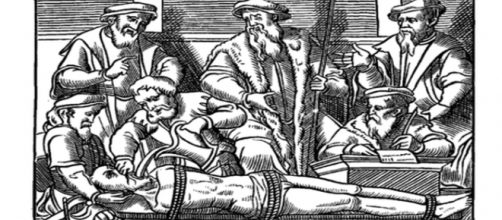Waterboarding at the CIA is in the news and it shouldn't be since President Obama barred the agency from using harsh interrogation techniques in 2009. But this news isn't about a current event. It's about an act of torture committed in 2002 that has come back to haunt us like a Gordian knot unraveling.
A world of hurt
Gina Haspel, Trump's pick to head the CIA, is a 33-year veteran of the agency and a logical choice. But in her tenure, she oversaw a secret detention center in Thailand where an Al-Qaeda detainee underwent waterboarding. She also took part in the shredding of a reported 100 videos of the agency's interrogations.
Granted, the Bush administration allowed waterboarding at the time and one might say she was simply following orders; except, as the Nuremberg trials taught the world, "the devil made me do it" is not an excuse for a war crime.
Show and tell
Let's see what we're talking about. Regard the image illustrating this writing, a 16th century Dutch wood cut. What you see is water being poured down the throat of a figure held fast by ropes and prevented from breathing. Observe how his nose is pinched shut. The experience is said to produce a sensation similar to drowning. If prolonged, this act of torture can lead to death. And if not death, deprivation of air can also damage the brain and lungs. Now observe how the witnesses react to the scene.
No one looks away or even grimaces. The facial expression of one figure (on the left) even bears a kind of beatific air, as if he were watching some blessed event.
Clouding the issue
One may well wonder what Haspel's face showed when the torture was taking place in her detention facility. And here's another thing to wonder about: why the president's Press Secretary Sarah Huckabee Sanders tweeted support for this nominee: “Any Democrat who claims to support woman's empowerment and our national security but opposes her nomination is a total hypocrite.” First of all, Sarah, your job is to report the news, not create it. And second, what do women's rights have to do with any of this? I'm all for empowerment, but should it include the power to brutalize?
Tunnel vision
And while I'm at it, what's up with all the artists in history who opted to picture torture, and worse, make it look beautiful? Let's toss around for a moment Titian's highly touted “The Flaying of Marsysas.” When it showed at the Royal Academy in London in 1983, it was hailed as the "star attraction." Mind you, we're talking about a depiction of someone getting skinned alive. It's doubtful it was a commission. Titian's client at the time was King Philip of Spain and it wasn't in his collection. Who would want such a thing anyway? Yet critics raved. Typical was Sidney Freed who rhapsodized about how “the surfaces of bodies make a silvered incandescence,” oblivious to the torture. He even claimed a “sense of the sublime.” Is that how Haspel was able to stomach what she allowed?


